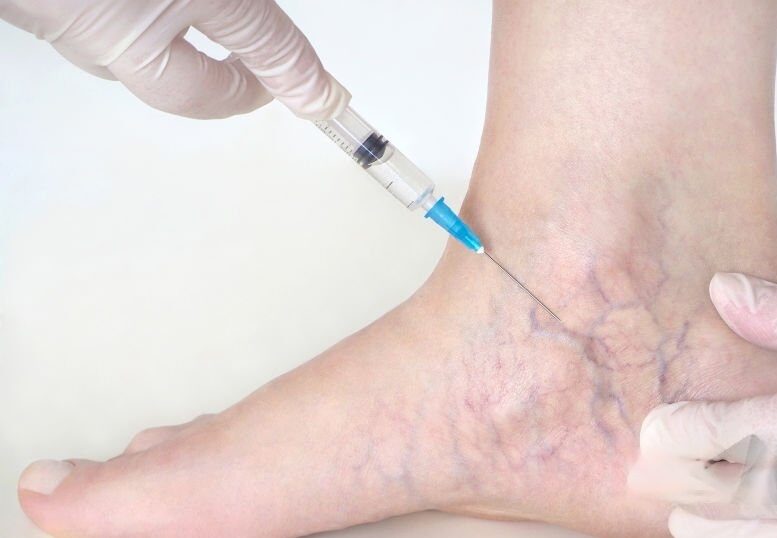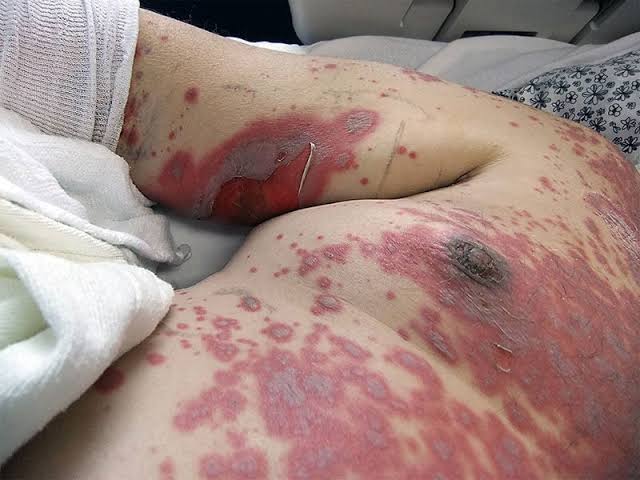Quick Facts
- Def -Sclerotherapy is a minimally invasive treatment for varicose and spider veins.
- Procedure: Injection of a sclerosing agent causes targeted veins to collapse and fade.
- Indications: Primarily cosmetic, it can also relieve symptoms like pain and swelling.
- Veins Treated: Effective for small to medium-sized veins.
- Sclerosing Agents: Various options include saline, STS, polidocanol, and glycerin.
- Duration: Sessions typically last 15 minutes to an hour.
- Recovery: Resume normal activities soon after, with visible results in weeks to months.
- Side Effects: Bruising, swelling, discomfort; rare complications like allergic reactions or skin ulceration.
- Post-Procedure Care: Compression stockings and sun protection advised.

Introduction:
In the realm of vascular medicine, sclerotherapy emerges as a frontline treatment option for patients grappling with the discomfort and aesthetic concerns posed by varicose and spider veins. Through the targeted administration of sclerosing agents, this procedure aims to obliterate abnormal veins, restoring both function and appearance.
What's the Procedure?pic.twitter.com/LG8Mk4xnJF
— Modern Health (@modernHealthMe) April 24, 2024
What is Sclerotherapy?
Procedure Overview
- Patient Assessment: Prior to treatment, a comprehensive evaluation of the patient’s vascular health and medical history is conducted to determine candidacy for sclerotherapy.
- Preparation: The treatment area is cleansed and marked to identify the target veins. Patients are typically advised to avoid certain medications, such as aspirin and nonsteroidal anti-inflammatory drugs (NSAIDs), prior to the procedure to minimize bruising and bleeding.
- Selection of Sclerosant: A sclerosing solution, commonly consisting of saline solution mixed with a sclerosant agent such as polidocanol or sodium tetradecyl sulfate, is prepared for injection.
- Injection Technique: Using a fine needle, the sclerosing solution is meticulously injected into the abnormal veins under ultrasound guidance or direct visualization. The solution irritates the vein lining, causing it to collapse and seal shut.
- Compression Therapy: Following injection, compression stockings or bandages are applied to promote vein closure and reduce the risk of complications such as bruising and thrombosis.
- Post-procedure Care: Patients are instructed to engage in light physical activity and avoid prolonged sitting or standing immediately after treatment. Regular follow-up appointments may be scheduled to assess treatment efficacy and address any concerns.
Indications for Sclerotherapy:
Sclerotherapy is a versatile procedure with several indications, making it a valuable treatment option for various venous disorders. Here are the primary indications for sclerotherapy:
1. Varicose Veins
Varicose veins are enlarged, twisted veins that often appear blue or dark purple and may bulge from the surface of the skin. Sclerotherapy is particularly effective for treating small to medium-sized varicose veins, especially those that are superficial and close to the skin’s surface. By injecting a sclerosing agent directly into the affected veins, sclerotherapy causes them to collapse and eventually fade from view, relieving discomfort and improving the appearance of the legs.
2. Spider Veins (Telangiectasia)
Spider veins, also known as telangiectasia, are small, dilated blood vessels that appear close to the skin’s surface, resembling spider webs or tree branches. While spider veins are usually harmless, they can be unsightly and may cause discomfort in some cases. Sclerotherapy is highly effective for eliminating spider veins, providing patients with smoother, clearer skin and boosting self-confidence.
3. Symptomatic Relief
Beyond cosmetic concerns, sclerotherapy can also provide symptomatic relief for individuals experiencing discomfort associated with venous insufficiency. Symptoms such as aching, swelling, heaviness, and cramping in the legs can be alleviated by reducing the size and pressure of varicose veins through sclerotherapy. By improving venous circulation and reducing venous congestion, sclerotherapy helps restore comfort and mobility to affected individuals.
4. Chronic Venous Insufficiency (CVI)
Chronic venous insufficiency (CVI) is a condition characterized by impaired blood flow in the veins, often resulting from damaged or dysfunctional venous valves. Sclerotherapy can be part of the comprehensive management approach for CVI, helping to address the underlying venous abnormalities and improve venous function. By closing off incompetent veins and redirecting blood flow to healthier vessels, sclerotherapy contributes to the overall management of CVI and may prevent complications such as venous ulcers and skin changes.
5. Preparation for Other Treatments
In some cases, sclerotherapy may be used as a preparatory or adjunctive treatment for more invasive procedures, such as endovenous laser therapy (EVLT) or radiofrequency ablation (RFA). By reducing the size and severity of varicose veins through sclerotherapy, these procedures may become more effective and less technically challenging, leading to better outcomes for patients with complex venous issues.

BloodFlowCare

Boxania® Varicose Veins Cream
Benefits of Sclerotherapy:
- Minimally Invasive: Sclerotherapy is performed on an outpatient basis, requiring no general anesthesia or surgical incisions.
- High Success Rate: When performed by a skilled practitioner, sclerotherapy yields high rates of vein closure and patient satisfaction.
- Quick Recovery: Most patients can resume normal activities immediately after treatment, with minimal downtime or discomfort.
- Cosmetic Improvement: Sclerotherapy not only addresses the functional aspects of venous insufficiency but also enhances the cosmetic appearance of the treated area.
Risks and Complications:
While sclerotherapy is generally considered safe, potential risks and complications include:
- Temporary Side Effects: Mild bruising, swelling, and discomfort at the injection site are common and typically resolve within a few days.
- Hyperpigmentation: Some patients may experience temporary darkening of the skin along the treated veins, which usually fades over time.
- Allergic Reaction: Although rare, allergic reactions to the sclerosing solution can occur, necessitating prompt medical attention.
Summary:
In summary, sclerotherapy stands as a safe and effective treatment modality for varicose and spider veins, offering patients a non-surgical solution with minimal downtime and impressive cosmetic results.
Frequently Asked Questions – FAQs on Sclerotherapy :
1. What is sclerotherapy used for?
Sclerotherapy is primarily used for the treatment of varicose veins and spider veins. It involves injecting a sclerosing agent directly into the affected veins, causing them to collapse and eventually fade from view. Sclerotherapy can also provide symptomatic relief for individuals experiencing discomfort associated with venous insufficiency.
2. How long does sclerotherapy last?
The duration of sclerotherapy results can vary depending on the size and severity of the treated veins, as well as individual factors such as lifestyle and genetics. In general, patients can expect to see significant improvement in the appearance of treated veins within a few weeks to a few months after the procedure. However, periodic touch-up treatments may be necessary to maintain optimal results over time.
3. How painful is sclerotherapy?
Sclerotherapy is typically well-tolerated by most patients and is associated with minimal discomfort. The injection itself may cause a mild stinging or burning sensation, similar to a small pinprick. Some patients may experience temporary discomfort or cramping in the treated area during and immediately after the procedure, but this usually subsides quickly.
4. What are the disadvantages of sclerotherapy?
While sclerotherapy is generally considered safe and effective, there are some potential disadvantages to consider. These may include temporary side effects such as bruising, swelling, and skin discoloration, as well as more rare complications such as allergic reactions or blood clots. Additionally, sclerotherapy may not be suitable for all individuals, particularly those with certain medical conditions or a history of adverse reactions to sclerosing agents.
5. What is the side effect of sclerotherapy?
Common side effects of sclerotherapy may include temporary bruising, swelling, and skin discoloration at the injection site. Some patients may also experience itching or mild discomfort in the treated area. Serious side effects are rare but may include allergic reactions, blood clots, or damage to nearby tissues or nerves.
6. Is sclerotherapy safe for piles?
Sclerotherapy is not typically used for the treatment of hemorrhoids (piles). While it may be effective for shrinking the blood vessels associated with hemorrhoids, other treatments such as rubber band ligation or hemorrhoidectomy are generally preferred for this condition.
7. Is sclerotherapy a risk?
Like any medical procedure, sclerotherapy carries some degree of risk, although serious complications are rare. Potential risks include allergic reactions, blood clots, infection, skin ulceration, or damage to nearby tissues or nerves. However, when performed by a qualified and experienced healthcare provider, sclerotherapy is generally considered safe and well-tolerated.
8. Which is better, sclerotherapy or laser?
The choice between sclerotherapy and laser therapy for the treatment of varicose veins or spider veins depends on various factors, including the size and location of the veins, the patient’s medical history, and their treatment preferences. Both sclerotherapy and laser therapy can be effective options, and a consultation with a vascular specialist can help determine the most appropriate treatment approach for each individual.
9. Can sclerotherapy damage nerves?
While sclerotherapy is generally considered safe, there is a potential risk of nerve damage, particularly if the sclerosing agent is inadvertently injected into surrounding tissues. This may result in temporary or permanent numbness, tingling, or nerve irritation. However, such complications are rare and can often be avoided by ensuring proper injection technique and careful patient selection.
10. Is sclerotherapy better than surgery?
The choice between sclerotherapy and surgery for the treatment of varicose veins depends on several factors, including the size and severity of the veins, the patient’s overall health, and their treatment goals. Sclerotherapy is typically less invasive and associated with fewer risks and complications compared to surgery, making it a preferred option for many patients. However, in some cases, surgery may be necessary to address more severe or complex venous issues.
11. Does sclerotherapy destroy veins?
Yes, sclerotherapy is designed to destroy abnormal veins by causing them to collapse and seal shut. Once injected with a sclerosing agent, the walls of the treated veins become irritated and eventually scar, leading to their closure and reabsorption by the body. Over time, the destroyed veins are replaced with healthy tissue, and blood flow is rerouted to nearby, healthy veins.
12. Can you walk after sclerotherapy?
Yes, patients are typically encouraged to engage in light physical activity, such as walking, immediately after sclerotherapy. Walking helps promote blood circulation and may reduce the risk of complications such as blood clots. However, strenuous exercise and activities that involve heavy lifting should be avoided for a short period following the procedure to minimize strain on the treated veins.
13. Is sclerotherapy bad for your veins?
Sclerotherapy is generally safe and well-tolerated when performed by a qualified and experienced healthcare provider. While it may cause temporary side effects such as bruising, swelling, or skin discoloration, serious complications are rare. In fact, sclerotherapy is often recommended as a first-line treatment for varicose veins and spider veins, offering effective results with minimal downtime and discomfort.
• Read More:

